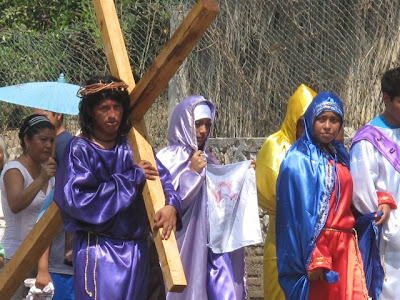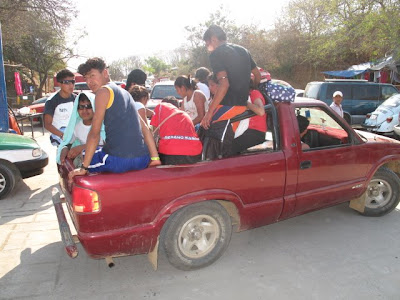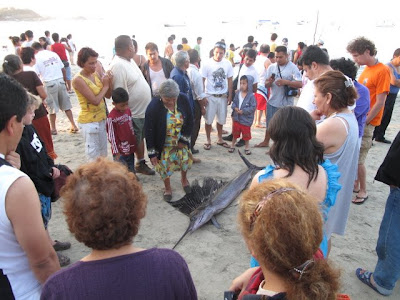


Zihuatanejo, Guerrero 15-28 March 2009
Zihuaaaaa! We washed up at the south end of Playa la Ropa, parked in an RV park at the rear of a restaurant just off the beach. We are appreciating more and more being somewhere other than right on the beach, where the wind and the waves pummel a person relentlessly. Our spot at the El Manglar is ideal, with but a short walk across a wooden bridge that spans the lagoon to the beach. The restaurant palapa is isolated from the beach as a result, but the breeze still blows through, making it a very pleasant place to hang out. The food is good, too, and the staff extremely helpful and pleasant. The only drawback is that our parking spot is directly exposed to the sun by about 9:00 AM, when the sun clears the surrounding jungle, and the airless parking lot becomes a sauna. It became a stressful thing (oh, the burdens we bear) to be up,exercised, breakfasted and cleaned up before the sun started to bore a hole in our brains. What else could we do but go to the beach?
The beach is wonderful, with a sandy bottom (which also describes us at the end of the day) and a gentle surf in which the boys were able to play for hours. Liz and I would get up and work out on the beach while it was cool first thing in the morning and the restaurants were still setting up. There were a lot of people out running the beach, which made for a good audience for Remy while he did his own routine involving the heaving of boulders and chin ups in a tree. We did all the usual beach things, buying from the vendors and going for a parasailing trip. It turned out that we picked the best crew, who happened to be the ones that stored their equipment in the RV park at night. Bowen rode with Liz while Remy and Hollis bravely did solo trips (I won't say who was the more nervous). Conditions were perfect and all our landings were textbook. We did see some of the other parasailing crews up the beach drop their clientele in the drink or bring them down for rough landings through he course of our stay. We also heard stories about clients cords getting tangled in the masts of the moored sailboats and in one case causing it to capsize. We're happy we heard these stories after we had done the ride.
We took one morning and hiked to Las Gatas beach, following the road to its end and then the pathway along the rocks. We braved the gauntlet of enramada restaurant owners, each of whom highjacked us along the way in an effort to gain our patronage. Each has their own tactic- one offers the best access to the water for snorkeling, another has sea turtles in a large plastic tub.(this infuriated Liz and Hollis to the point where they told the owner they wouldn't patronize his establishment because of his capture of these sea creatures.) The one that offered beers for M$10 (a dollar) had Remy hooked, but we were only on a recce.
We continued to the far end of the beach and found the Las Gatas beach club, which we ultimately learned is the home of Owen Lee, a local personality (or rogue, depending on whom you speak to). He was the first American to work with Jacques Cousteau as a camera man on the Calypso, and when he was no longer able to work on the boat became Cousteau's touring speaker. He has lived at Las Gatas beach since 1968. He is in his eighties now, but still remarkably fit. We purchased his autobiography from him, which Liz spent the next week reading while sitting on the beach, looking across the bay at Owen Lee's home. The book, A Prisoner in Paradise, is an unwitting tale of hubris on Owen's part, and details a lot of the local history and the other rogues with whom Owen has consorted during his time here.
While in Zihuatanejo, what had begun in Tenacatita as a pimply-looking sore on Remy's right knee cap flared up into a disgusting, oozing pustule that radiated pain all down his right leg and caused his foot to swell. Liz obtained a referral to a doctor from one of the other park dwellers. The doctor didn't bother taking any sort of medical history or vital signs, just asking instead "What is the problem?" When shown the affliction, he pronounced it right away as a parasite whose vector to humans is through dogs. A quick prescription and M$500 (fifty bucks) later and Remy was on his way. A couple of days after taking the one day course of bug-killing medicine, Remy pulled an ugly wad of white tissue from the open sore on his knee, which as of writing two weeks later is still not completely closed up. The reaction that Remy's bandaged wound got from other tourists was to be solicitously asked, "Did you get that from (fill in the blank with every tourist activity you can think of- horseback riding, parasailing, snorkeling, etc.)?" Being unable to lie, Remy would answer honestly with, "Nope, knelt in dog shit and got a parasite." The reaction was funny, but we sure didn't make any new friends, especially those seated next to us at dinner.
Remy's mother, Sharon, and her friend Molly Ann arrived in Ixtapa after we had been in Zihuatanejo for a week. We met them the first day after they arrived and had a swim in the pool. The boys stayed in their room and watched movies while Liz and Remy caught the opening show of the Zihuatanejo International Guitar Festival, which consisted of most of the artists taking turns giving a two or three song taster of the their music. That helped us choose who we wanted to see later in the week. We caught the Pistoleros at the children's concert, and Liz and Remy went out for dinner one night to see Cienfue, a Panamanian singer-songwriter, and Patrick Sweany, an awesome American blues artist with a very distinctive style.
We have to mention here even though Hollis might be upset that we are "telling everyone". While at the bathroom after the children's fest concert, Sharon noticed that a gaggle of girls were hanging around looking at Hollis. I was sure she was imagining but sure enough a whole gang- like 30, were surrounding him and clicking photos on their cell phones. He patiently waited for them to take a photo then asked if we could please leave NOW! As we were leaving the girl in the photo followed us to get her shot. Wow, this is most definitely a new chapter in the parenting book for both his parents. I guess he is as adorable as we have always thought he was.
We did go back to the resort in Ixtapa another day to visit with Mom and Molly Ann. The boys were in the pool when Remy was informed that we all had to be signed in as guests, as it is an all-inclusive resort. We found out that they wanted to charge us M$600 (sixty dollars) per head for the privilege of using the amenities at their rundown, 2 1/2 star resort. We went back to Mom and Molly Ann's room and found out that we were not even supposed to be there, as guests are not allowed in the rooms. We repaired to the lobby, which is the designated visiting area. The resort was dead, and we were among what was very few people at the resort and greatly outnumbered by staff. We played a couple of games of Scrabble while the security staff hovered around, having identified us all as rabble rousers. Before leaving, we went to get into the elevator to get our stuff from Mom's room, but were were accosted at the door and physically prevented from getting on. We tried to explain that we only wished to retrieve our stuff, but the staff understood no English and our Spanish was not up to the task as the elevator door was closing repeatedly on various limbs. We retreated and explained our situation to another staff member, who finally allowed that one member of our party could go up to my mother's room, by which time she had already gone and returned with our bags of stuff. This was only one of a few situations that unfortunately made Mom feel like she was besieged in the resort, instead of being an esteemed guest. It was the one inhospitable moment we have so far experienced in Mexico, and is characteristic of the fact that Ixtapa is a completely artificial construction of Norteamericano values in what is otherwise an extremely friendly and hospitable culture. If your travel agent ever wants you to go to the Hotel Fontan in Ixtapa, don't go.
Luckily, this all happened after Liz and Bowen and Mom got their 15 minutes of fame on the beach in Zihuatanejo. Liz had met and agreed to be interviewed by a Canadian crew that was hired by the Mexican government to do a series highlighting the safe and fun nature of tourism in Mexico to combat all the bad press that the last American administration had fed to the media. If you want to check out www.whatisreallyhappeninginmexico.com, go to the interviews from Zihuatanejo in Part 2 and you will see the photogenic Liz and Bowen in one, my mom in another, and a third installment we were not aware of until later, when they filmed around our camper van while we were at the beach. A pretty cool souvenir of the trip!
-Remy


 Tuxla & Chiapa de Corzo, Oaxaca
Tuxla & Chiapa de Corzo, Oaxaca






















